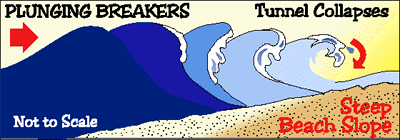|
Swells are smooth, rounded waves that travel outward from a storm center or continue as broad undulations of the ocean surface after the wind dies down. The wave slope is expressed as the ratio of the wave height to wave length, ranging from 1:25 to 1:50. A wave will become unstable at slopes greater than 1:7 and will fall over itself, or break.
Figure 21.6 Plunging breakers. (Courtesy Naval Meteorology Program and Oceanography Command "Restless Sea") As a wave approaches the coast, a depth is reached offshore where the wave touches the ocean floor. The tug of the ocean floor changes the circular wave motion into an elliptical one; the water moves back and forth over the bottom as each wave passes. The friction imparted from the floor slows the wave base. At a depth of 1.3 times the wave length, the drag causes the top of the wave to rush forward, become unstable and break. Water in the breaking wave is transported toward shore as a wave of translation.
Figure 21.7 Breakers along Northern California coast
|
